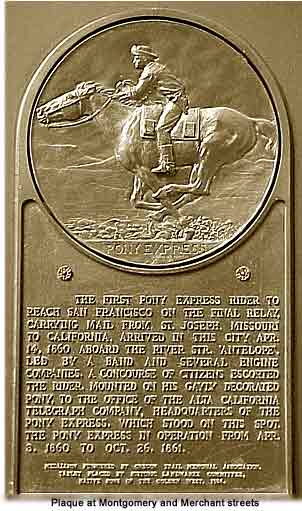|
||||
|
||||
|
|||||||||||||||||||

The early coaches of Wells Fargo consumed twenty days to cross from St. Joseph, Missouri, long considered a great outpost of civilization, to Sacramento. But twenty days to the merchants and bankers of the West Coast seemed an eternity, and so a short time before the beginning of the Civil War, the Pony Express came into existence. Having received assurances that fast communication from the Missouri River to California would be well patronized, three early stagecoach men, Senator W.M. Gwin, Alexander Majors and Daniel E. Phelps, made preparations for the inauguration of the new service. Six hundred broncos, especially chosen for fleetness, toughness and endurance, were purchased. Seventy-five men, none of them weighing over one hundred and ten pounds, were engaged as riders, being selected on account of their bravery, their capacity for deprivation and their horsemanship, as well as for their shooting abilities and their knowledge of the craft and the manner of attack of the Indians. One of these, Henry Wallace, was selected for the signal honor of inaugurating the Pony Express on April 3, 1860. In one of the laced pockets of his mochilla (Mexican saddlebags) he carried a message of congratulation from President Buchanan to the Governor of California, the words having been telegraphed that very morning from Washington to St. Joseph. The packet which Wallace had taken out from St. Joseph reached Sacramento, the capital of California, just ten days later -- almost to the very hour. Night and day it had been carried forward unceasingly. A rider would pick it from his predecessor and ride forth sixty miles at top speed to the point where his "relief" awaited him, to pick up the mochilla and start off in turn upon his sixty mile stretch. Six hour were given each of these riders for his sixty mile stint, and in this time he rode six different ponies.
Each day, except Sunday, a messenger left St. Joseph at noon, another coming east from Sacramento at eight o'clock in the morning. For two years this service was maintained, through good weather and bad. The news of the taking of Fort Sumter was transmitted to Sacramento, eight hundred miles, in eighteen days and fourteen hours; Buchanan's last message in two hours' less time. Yet the Pony Express was destined to have only a short, if glorious, career. For along its path men were stringing copper wires, even in advance of the steady oncoming of the railroad, and some time in the early part of 1862 the telegraph reached California, and the Pony Express was dead. Financially it had never been a success. The letters carried were written on very fine tissue paper; the cost of carrying between San Francisco and St. Joseph, Missouri 1,800 miles, was $5. The
first mail by Pony Express reached Sacramento, April 13, 1860. At that
time the company employed 300 person, 80 of them being riders whose average
performance was about 75 miles. There is a record of one who rode 384 While
various competitors in carrying mail and passengers were struggling among
themselves to capture the bulk of the overland trade, a little group of
Sacramento businessmen, Leland Stanford and Charles Crocker among them,
were steadily going forward on their Utopian scheme of building
a railroad up over the crest of the Sierra to connect with the great
Union Pacific Railway, already pushing itself westward from Omaha. They
were blasting a path for their steel highway out of the very sides of the
steep west slopes of California's great natural wall, and up that path
the little wood-burning locomotives that, like the stage coaches, had been
brought around the Horn in clipper ships, were already tugging patiently.
And it was only five years later that in the lonely Utah Desert, the rails
of the Central Pacific touched the rails of the Union Pacific.
|